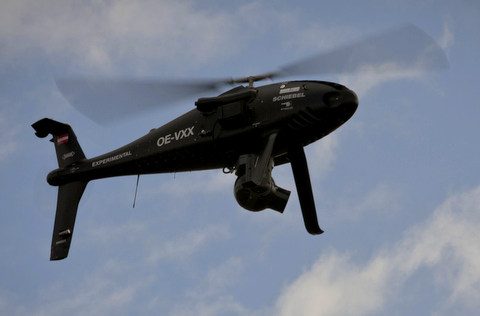Russell Peters is a junior at Embry-Riddle Aeronautical University (78211MF), one of the top U.S. flight-training schools, who has no intention of taking to the skies.
Standing next to a 3-foot-wide (91.4 centimeters) plane that searches for objects on the ground using artificial intelligence, he talks about how his fascination with robotics led him to theDaytona Beach, Florida, campus to prepare for a career building and operating drones.
I don’t care about flying the planes,” said Peters, of ColoradoSprings, Colorado. “I just want to make the planes. And if we can get rid of the pilots, that’s great.”
As the U.S. Federal Aviation Administration prepares to let civilian unmanned aircraft operate in domestic airspace, universities including Embry-Riddle have created majors in flying and building drones. Enrollment is accelerating as students look for new opportunities in an aviation job market pummeled by airline bankruptcies.
The drone industry, estimated worldwide at $5.9 billion annually, will expand to $11.3 billion by 2021, according to areport last year by the Teal Group Corp. of Fairfax, Virginia, which analyzes the industry. It’s “been the most dynamic growth sector of the aerospace industry this decade,” the firm said in the report.
...
Alex Mirot, a retired Air Force major who piloted Predator and Reaper unmanned vehicles built by General Atomics Inc. ofSan Diego, coordinates Embry-Riddle’s degree program inUnmanned Aerial Systems Science. In less than one year, 75 students have enrolled to major or minor in the subject, he said.
'Kind of Amazing'
“To me this is kind of amazing,” Mirot said in an office festooned with photos, ribbons and other memorabilia from his 10 years in the military. “That’s how popular this is as a technology.”
The program offers two tracks for students: training on simulators to be drone operators, or non-pilot roles such as operating remote-controlled cameras and managing unmanned- aircraft programs.
Students can take classes in how unmanned systems work, robotics, business management, operating remote sensors such as cameras and radars, and drone simulator training, Mirot said. They must take courses in electrical engineering and programming, he said.
Across campus at the Department of Mechanical, Civil and Engineering Sciences, students like Peters study how to build and design unmanned aircraft, Charles Reinholtz, the department chairman, said in an interview.
Graduates Getting Jobs
The University of North Dakota in Grand Forks established a drone-study major more than two years ago and has graduated 17 students, Benjamin M. Trapnell, an aeronautics professor who developed the program, said in a phone interview.
Graduates can expect to make starting salaries of at least $50,000, and perhaps double that if they accept jobs in dangerous locations, Trapnell said. That dwarfs entry-level salaries as airline pilots, which can be below $20,000, according to government data.
He said his graduates, who must obtain FAA commercial pilots’ licenses, have landed jobs with drone operators and manufacturers such as the Aeronautical & Space Systems division of Information Systems Laboratories Inc. of San Diego and AAI Unmanned Aircraft Systems, which is owned by Textron Inc. (TXT) of Providence, Rhode Island.
It’s premature to design courses and pilot training programs for unmanned aircraft because the government hasn’t yet outlined requirements for how they must be built and flown, said the head of the only U.S. civilian test bed for unmanned aircraft.
No U.S. Standards
“We’re having a hard time understanding how you develop a bachelor’s degree program when you have no federal standards,” Doug Davis, who directs the drone program at the New Mexico State University (28344MF) Physical Science Laboratory in Las Cruces, said in a phone interview.
Gene Gamble, an Embry-Riddle senior, is on a team led by Peters that plans to enter a national unmanned-aircraft contest later this spring. He said he relishes seeing the amazement of people who stop by the drone lab for tours.
“I do enjoy telling people that I work on robots that drive themselves,” said Gamble, who’s on a five-year program leading to a master’s degree in software engineering.
Gamble spoke while replacing the battery on a winged device slightly longer than one foot that hovers like a helicopter with one blade. The craft is based on the way a maple seed rotates as it falls from a tree.
Sensor Design
Using a hobbyist’s radio remote-control handset, he flew the device more than 10 feet up into an atrium. Gamble is helping design software and sensors that will eventually allow the device to fly and navigate itself.
“I’d like to work for a company that does things like this,” he said.
Michael Tagliereni, of Jackson, New Jersey, an Embry-Riddle senior majoring in aeronautics, said he enrolled in an introduction to unmanned aircraft class as a fallback in case he can’t find a job as a pilot or an air traffic controller.
Sitting next to him in a classroom, Paul Renart, a freshman from Warwick, New York, said he chose to major in drone studies because it will help his military career. Renart is in the Air Force Reserve Officer Training Corps.
For Peters, the junior drone-building enthusiast, his fascination with making intelligent machines has put him at the forefront of a field with a large measure of cool on campus.
“I like to be on the cutting edge,” Peters said. “I think it’s just the beginning.”
